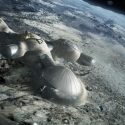The Titanosaur is no longer. As the largest animal to roam the Earth, you’d think such an impressive presence would be almost invincible. How did this titan of a creature finally meet its demise? It seems even the mightiest can fall. What is a Titanosaur? How did they end up on every continent? Why did they disappear?
Titanosaurs were part of a diverse group of dinosaurs called sauropods, from the Greek, meaning ‘lizard foot.’ Their enormous skeletal remains, along with immense lizard footprints, have been found all over the world. This global domination is both imposing and incredible. So, how did they end up on every continent?
Their extraordinary geographical distribution had to do with the splitting of the subcontinent Gondwana that took place at the end of the Cretaceous Period. These long-neck giants hitched a ride when this enormous landmass parted and they lumbered onward to new terra firma. The largest Titanosaur was discovered in Argentina in 1987. Appropriately dubbed the Argentinosaurus for this location, they lived between 100 to 93 million years ago.
Estimated to weigh up to 100 metric tons (110 tons) with a length ranging between 30 and 40 meters (100 to 130 feet) and as tall as 15 to 20 meters (50 to 65 feet). For some comparison, picture the towering height of a seven-story building or the Great Sphinx of Giza. Throw in the mass of 12 Asian elephants, or 2,200 kilograms (5,000 pounds). That’s more than a Boeing 737’s maximum takeoff weight. And even the lengthy stretch of an official NBA basketball court at 29 meters (50 feet) would only hold 75% of the creature’s body.
But don’t feel threatened by this brute, unless you’re a juicy fern. Titanosaurs were herbivores that ate a broad range of plants. They feasted continuously on approximately 900 kilograms (2,000 pounds) of greens a day. They weren’t overly picky and favored quantity to sustain their hefty nutritional demands. And they couldn’t be bothered by pointless chewing, instead swallowing their food whole, relying on the long trek down their neck to break things down.
Because of their massive size, they were able to cover a lot of ground without moving excessively and expending too much energy, with top speeds only averaging around 8 kilometers per hour (5 mph). A social bunch, they traveled in small herds and needed to continuously be on the move to fuel their gigantic appetites. So how did they die out? Their fate was sealed 66 million years ago, when an asteroid struck the Earth. Not only was this the end of the Titanosaurs, but it also wiped out 75% of life on Earth.
Yet if these titans managed to ride out changing times, they would’ve needed to overcome several catastrophic global extinctions. First, they’d have to sidestep the asteroid that wiped them out originally, then persevere when global warming spiked global temperatures 55 million years later, and also plow through the Ice Age 2.6 million years ago.
If they were here present day, consuming so much plant life, where would that leave us humans on the food chain? Evolving Titanosaurs could deplete the ecosystem of vegetation entirely and might be forced to become carnivores, and adapt to their ever changing environment. While they may not become pure meat eaters, they could become omnivores. And if they developed a taste for meat, who would be on the menu? You and I? This could create a scary ripple effect in the food chain and possibly cause many species to die off.
Since it’s possible we could be considered prey, we would be forced to live in the treetops. Maybe in a magical kingdom like Endor. Our new form of transportation could be the vines, swinging from tree to tree like Tarzan to avoid the treachery of open jaws below. But what if humans were able to tame the titan? Picture a happy, helpful Titanosaur on a construction site, working the gravel mines. Look familiar? Or, you could see them being useful and marching into battle like the Haradrims on giant elephants in The Lord of The Rings, taking out everything in their path.
And imagine how many mouths one of these giants could feed. The Titanosaur could become a source of food for humans and solve world hunger. This might force them to flee land and head to the water living off a plethora of underwater marine life and plankton. Wait, could it be possible the Titanosaur is actually alive today, hiding in murky depths off the coast of Inverness, Scotland?
Sources
- “Fossil Titanosaur Egg With Embryo Still Inside“. 2020. American Museum Of Natural History.
- “Titanic Dinosaurs Split By ‘Unzipping’ Supercontinent – Cosmos Magazine“. 2016. Cosmos Magazine.
- “The Saurischia“. 2020. Ucmp.Berkeley.Edu.
- “Walking With Dinosaurs | BBC Earth | Shows | BBC Earth“. Dinosaurs, Walking. 2020. BBC Earth.
- “Large Family | AMNH“. 2020. American Museum Of Natural History.
- “Titanosaur“. 2020. Fossil Wiki.



























